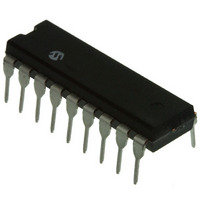PIC24HJ12GP201-I/P Microchip Technology, PIC24HJ12GP201-I/P Datasheet - Page 96

PIC24HJ12GP201-I/P
Manufacturer Part Number
PIC24HJ12GP201-I/P
Description
IC PIC MCU FLASH 4KX24 18DIP
Manufacturer
Microchip Technology
Series
PIC® 24Hr
Datasheets
1.PIC24HJ12GP201-ISO.pdf
(242 pages)
2.PIC24HJ12GP201-ISO.pdf
(8 pages)
3.PIC24HJ12GP201-ISO.pdf
(84 pages)
4.PIC24HJ12GP201-ISO.pdf
(12 pages)
5.PIC24HJ12GP201-IP.pdf
(234 pages)
Specifications of PIC24HJ12GP201-I/P
Program Memory Type
FLASH
Program Memory Size
12KB (4K x 24)
Package / Case
18-DIP (0.300", 7.62mm)
Core Processor
PIC
Core Size
16-Bit
Speed
40 MIPs
Connectivity
I²C, SPI, UART/USART
Peripherals
Brown-out Detect/Reset, POR, PWM, WDT
Number Of I /o
13
Ram Size
1K x 8
Voltage - Supply (vcc/vdd)
3 V ~ 3.6 V
Data Converters
A/D 6x10b/12b
Oscillator Type
Internal
Operating Temperature
-40°C ~ 85°C
Processor Series
PIC24HJ
Core
PIC
Data Bus Width
16 bit
Data Ram Size
1 KB
Interface Type
I2C/SPI/UART
Maximum Clock Frequency
40 MHz
Number Of Programmable I/os
13
Number Of Timers
3
Maximum Operating Temperature
+ 85 C
Mounting Style
Through Hole
3rd Party Development Tools
52713-733, 52714-737, 53276-922, EWDSPIC
Development Tools By Supplier
PG164130, DV164035, DV244005, DV164005, PG164120
Minimum Operating Temperature
- 40 C
On-chip Adc
6-ch x 10-bit or 6-ch x 12-bit
Lead Free Status / RoHS Status
Lead free / RoHS Compliant
For Use With
AC164337 - MODULE SOCKET FOR PM3 40DIP
Eeprom Size
-
Lead Free Status / Rohs Status
Lead free / RoHS Compliant
PIC24HJ12GP201/202
9.4.3.3
The control schema of peripheral select pins is not lim-
ited to a small range of fixed peripheral configurations.
There are no mutual or hardware-enforced lockouts
between any of the peripheral mapping SFRs. Literally
any combination of peripheral mappings across any or
all of the RPn pins is possible. This includes both
many-to-one and one-to-many mappings of peripheral
inputs and outputs to pins.
While such mappings may be technically possible from
a configuration point of view, they may not be
supportable electrically.
9.4.4
Because peripheral remapping can be changed during
run time, some restrictions on peripheral remapping
are needed to prevent accidental configuration
changes. PIC24H devices include three features to
prevent alterations to the peripheral map:
• Control register lock sequence
• Continuous state monitoring
• Configuration bit pin select lock
9.4.4.1
Under normal operation, writes to the RPINRx and
RPORx registers are not allowed. Attempted writes
appear to execute normally, but the contents of the
registers remain unchanged. To change these
registers, they must be unlocked in hardware. The
register lock is controlled by the IOLOCK bit
(OSCCON<6>). Setting IOLOCK prevents writes to
the control registers; clearing IOLOCK allows writes.
To set or clear IOLOCK, a specific command sequence
must be executed:
1.
2.
3.
Unlike the similar sequence with the oscillator’s LOCK
bit, IOLOCK remains in one state until changed. This
allows all of the peripheral pin selects to be configured
with a single unlock sequence followed by an update to
all control registers, then locked with a second lock
sequence.
DS70282B-page 94
Note:
Write 0x46 to OSCCON<7:0>.
Write 0x57 to OSCCON<7:0>.
Clear (or set) IOLOCK as a single operation.
CONTROLLING CONFIGURATION
CHANGES
MPLAB
functions for unlocking the OSCCON
register:
See MPLAB IDE
information.
Mapping
Control Register Lock
__builtin_write_OSCCONL(value)
__builtin_write_OSCCONH(value)
®
C30 provides built-in C language
Help for more
Preliminary
9.4.4.2
In addition to being protected from direct writes, the
contents of the RPINRx and RPORx registers are
constantly monitored in hardware by shadow registers.
If an unexpected change in any of the registers occurs
(such as cell disturbances caused by ESD or other
external events), a configuration mismatch Reset will
be triggered.
9.4.4.3
As an additional level of safety, the device can be
configured to prevent more than one write session to
the RPINRx and RPORx registers. The IOL1WAY
(FOSC<IOL1WAY>) configuration bit blocks the
IOLOCK bit from being cleared after it has been set
once.
In the default (unprogrammed) state, IOL1WAY is set,
restricting users to one write session. Programming
IOL1WAY allows user applications unlimited access
(with the proper use of the unlock sequence) to the
peripheral pin select registers.
9.4.5
The ability to control peripheral pin selection
introduces several considerations into application
design, including several common peripherals that are
only available as remappable peripherals.
9.4.5.1
The peripheral pin selects are not available on default
pins in the device’s default (Reset) state. More
specifically, since all RPINRx and RPORx registers
reset to 0000h, this means all peripheral pin select
inputs are tied to RP0, while all peripheral pin select
outputs are disconnected. This means that before any
other application code is executed, the user application
must initialize the device with the proper peripheral
configuration.
Since the IOLOCK bit resets in the unlocked state, it is
not necessary to execute the unlock sequence after
the device has come out of Reset. For the sake of
application safety, however, it is always a good idea to
set IOLOCK and lock the configuration after writing to
the control registers.
Because the unlock sequence is timing critical, it must
be executed as an assembly language routine, in the
same
configuration. If the bulk of the application is written in
C or another high-level language, the unlock sequence
should be performed by writing inline assembly.
manner
CONSIDERATIONS FOR
PERIPHERAL PIN SELECTION
Continuous State Monitoring
Configuration Bit Pin Select Lock
Configuration
as
changes
© 2007 Microchip Technology Inc.
to
the
oscillator











